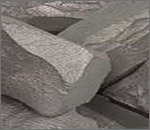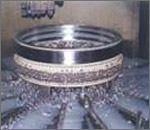Titanium is a chemical element with the symbol Ti and atomic number 22. Sometimes called the “space age metal”, it has a low density and is a strong, lustrous, corrosion-resistant (incl

uding sea water, aqua regia and chlorine) transition metal with a silver color.
Titanium can be alloyed with iron, aluminium, vanadium, molybdenum, among other elements, to produce strong lightweight alloys for aerospace (jet engines, missiles, and spacecraft), military, industrial process (chemicals and petro-chemicals, desalination plants, pulp, and paper), automotive, agri-food, medical prostheses, orthopedic implants, dental and endodontic instruments and files, dental implants, sporting goods, jewelry, mobile phones, and other applications. Titanium was discovered in England by William Gregor in 1791 and named by Martin Heinrich Klaproth for the Titans of Greek mythology.
The element occurs within a number of mineral deposits, principally rutile and ilmenite, which are widely distributed in the Earth's crust and lithosphere, and it is found in almost all living things, rocks, water bodies, and soils. The metal is extracted from its principal mineral ores via the Kroll process or the Hunter process. Its most common compound, titanium dioxide, is used in the manufacture of white pigments. Other compounds include titanium tetrachloride (TiCl4) (used in smoke screens/skywriting and as a catalyst) and titanium trichloride (TiCl3) (used as a catalyst in the production of polypropylene).
The two most useful properties of the metal form are corrosion resistance and the highest strength-to-weight ratio of any metal. In its unalloyed condition, titanium is as strong as some steels, but 45% lighter. There are two allotropic forms and five naturally occurring isotopes of this element; 46Ti through 50Ti, with 48Ti being the most abundant (73.8%). Titanium's propertiesare chemically and physically similar to zirconium.
Titanium was discovered included in a mineral in Cornwall, England, in 1791 by amateur geologist and pastor William Gregor, then vicar of Creed parish. He recognized the presence of a new element in ilmenite when he found black sand by a stream in the nearby parish of Manaccan and noticed the sand was attracted by a magnet. Analysis of the sand determined the presence

of two metal oxides; iron oxide (explaining the attraction to the magnet) and 45.25% of a white metallic oxide he could not identify. Gregor, realizing that the unidentified oxide contained a metal that did not match the properties of any known element, reported his findings to the Royal Geological Society of Cornwall and in the German science journal Crell's Annalen.
Around the same time, Franz-Joseph Müller von Reichenstein produced a similar substance, but could not identify it. The oxide was independently rediscovered in 1795 by German chemist Martin Heinrich Klaproth in rutile from Hungary. Klaproth found that it contained a new element and named it for the Titans of Greek mythology. After hearing about Gregor's earlier discovery, he obtained a sample of manaccanite and confirmed it contained titanium.
The processes required to extract titanium from its various ores are laborious and costly; it is not possible to reduce in the normal manner, by heating in the presence of carbon, becausethat produces titanium carbide. Pure metallic titanium (99.9%) was first prepared in 1910 by Matthew A. Hunter at Rensselaer Polytechnic Institute by heating TiCl4 with sodium at 700–800 °Cin the Hunter process. Titanium metal was not used outside the laboratory until 1932 when William Justin Kroll proved that it could be produced by reducing titanium tetrachloride (TiCl4) with calcium. Eight years later he refined this process by using magnesium and even sodium in what became known as the Kroll process. Although research continues into more efficient and cheaper processes (e.g., FFC Cambridge), the Kroll process is still used for commercial production.
Titanium of very high purity was made in small quantities when Anton Eduard van Arkel and Jan Hendrik de Boer discovered the iodide, or crystal bar, process in 1925, by reacting with iodine and decomposing the formed vapors over a hot filament to pure metal.
In the 1950s and 1960s the Soviet Union pioneered the use of titanium in military and submarine applications (Alfa Class and Mike Class) as part of programs related to the Cold W

ar. Starting in the early 1950s, titanium began to be used extensively for military aviation purposes, particularly in high-performance jets, starting with aircraft such as the F100 Super Sabre and Lockheed A-12.
In the USA, the Department of Defense realized the strategic importance of the metal and supported early efforts of commercialization. Throughout the period of the ColdWar, titanium was considered a Strategic Material by the U.S. government, and a large stockpile of titanium sponge was maintained by the Defense National Stockpile Center, which was finally depleted in 2005. Today, the world's largest producer, Russian-based VSMPO-Avisma, is estimated to account for about 29% of the world market share.
In 2006, the U.S. Defense Agency awarded $5.7 million to a two-company consortium to develop a new process for making titanium metal powder. Under heat and pressure, the powder can be used to create strong, lightweight items ranging from armor plating to components for the aerospace, transportation, and chemical processing industries.


